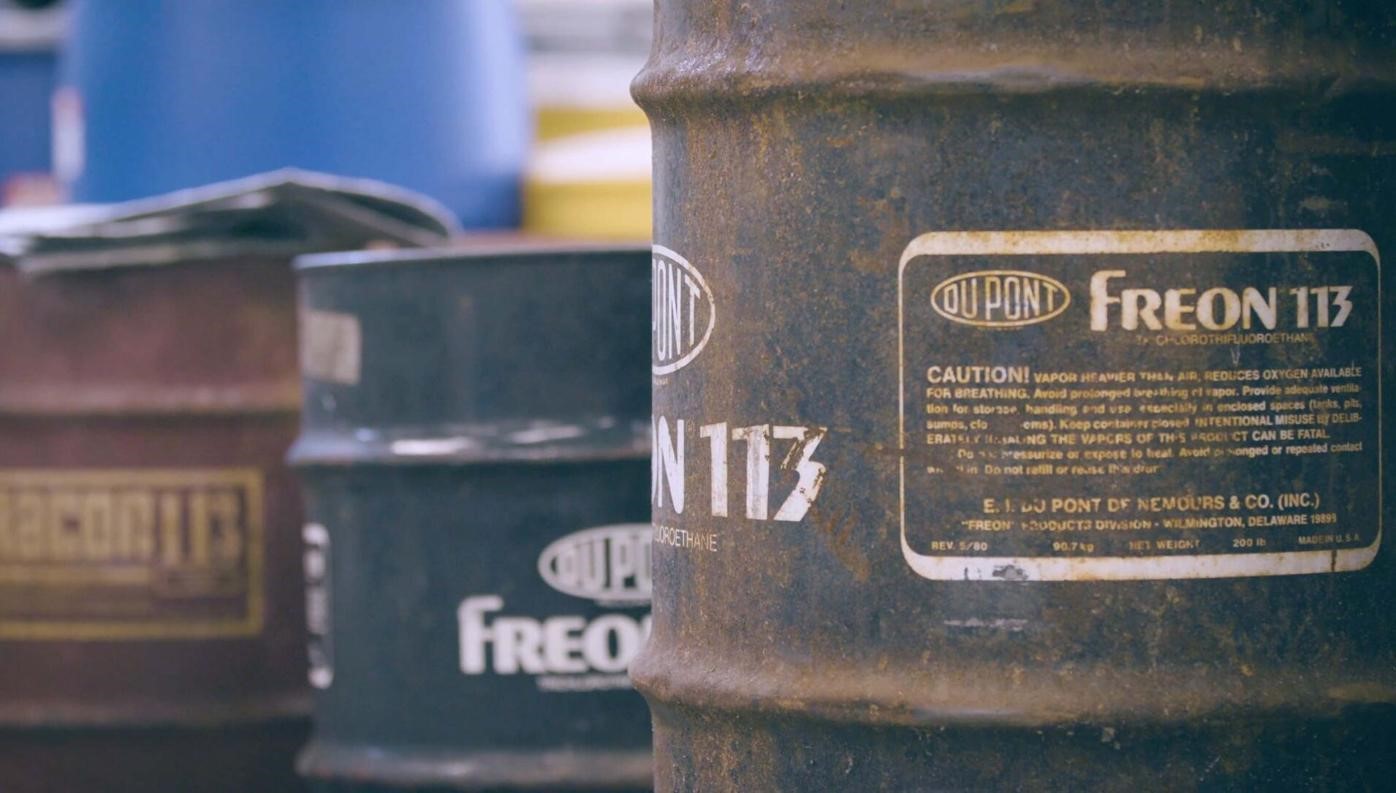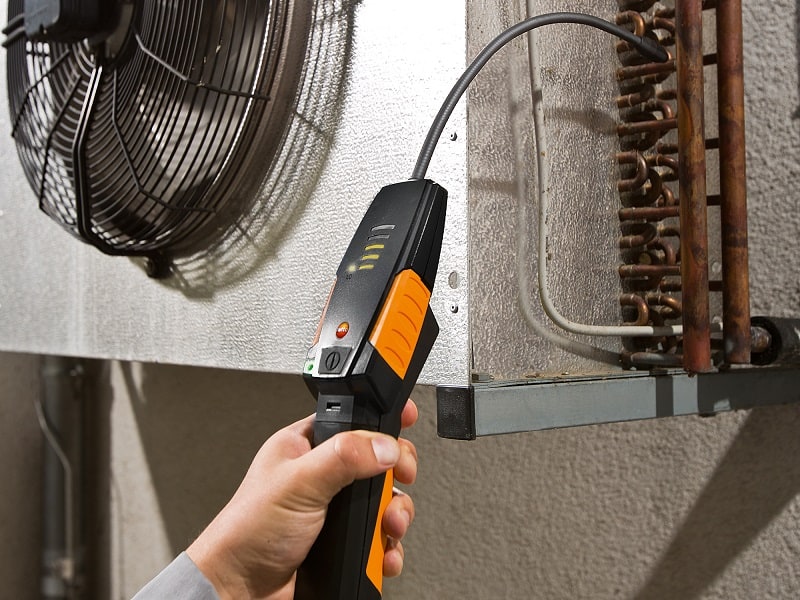
Trakref
Destruction is a Better Option Than Refrigeration Recycling

I want to tell you how I came to realize that destruction is a better option than refrigeration recycling for environmental sustainability and a company’s environmental footprint.
Years ago, I ran one of the largest reclamation companies in the United States. We processed millions of pounds of gasses each year. Along the way, we became evangelists for proper reclaiming and recycling requirements. Our goal was to reduce mixed gas, so the yields of good gas were higher. Over time, I realized the industry in which I was a part had no interest in implementing real-world requirements that would make the reclamation and recycling process enough to have a positive impact on climate change.
More about my personal journey to this revelation later in this article.
Today, Trakref shares our commitment to a process that requires the destruction of all used refrigerants. Venting these gases harms the atmosphere, causing further global warming. Refrigerant recycling and refrigerant recovery, even when effectively monitored, inevitably leads to venting.
At this point, we have witnessed five generations since the shift away from CFCs in the early 90’s. These five iterations include CFCs, HCFCs, HFCs, HFOs, and the emergence of natural refrigerants (ammonia, propane, etc.) Currently, the primary ones in the market are HFCs, a class with a very high GWP impact, as much as two tons of carbon per pound.
In August 2019, Environmental Protection Agency Administrator Andrew Wheeler publicly acknowledged that ultimately all refrigerants are vented. Reading the information in this statement two years ago was a watershed moment for me.
“…given the agency’s assumption that all refrigerant produced is eventually emitted into the atmosphere. More allocated allowances would likely suppress the recovery and reclamation market and cause more HCFC material to be vented at the end of the equipment’s’ lifetime”
Although the EPA has regulations and processes in place to curb emissions of equipment and recycling equipment, the rapid pace of venting increases exponentially. This quote from the EPA is further evidence why having a process that requires the destruction of all end-of-life refrigerants is imperative.
Why do we advocate for the destruction of all used refrigerant gases over recycling? The answer is simple. Recycling inevitably leads to venting. Venting these gases harms the atmosphere, causing further global warming. Conclusion: destruction is the absolute best option.
Here is the problem we all face.
Older equipment has an end-of-life legal requirement that the gas will be extracted and sent to a certified recycling program and go through their system. Once these are removed, the gas goes through recovery and is transported to a reclaim company where it is processed and returned to its original state. This process is referred to as reclamation and extricated gas is referred to as reclaimed or reclaimed refrigerant. However, a fundamental flaw in the current system signifies “reclaim” as a process and not a material. The consequence of this is that refrigerant cannot be labeled as “reclaimed.” This hides the fact of the gas’s origin, with the consumer left in the dark as to the true source of the gas. After it is processed at a certified US EPA reclaim site and goes through their system, it is then made available for resale. Since many obsolete systems remain in place, the recovered CFC and HCFC are valuable sources of raw materials to keep the aging fleet of CFC and HCFC-based appliances operating. Consequently, the reclaimed gas is back in service. But due to the leak rate, it inevitably escapes during the operation of the older system into which it has been installed.
How and why does it work this way?
In the US, leak rates for equipment average 25% from equipment older than six years, despite corporate sustainability efforts. CFCs, are the most destructive class. They cause harmful impacts to the Ozone and they possess a high GWP.
A recent MIT study calculates that continued emissions from stored CFCs have a GWP of 9 billion metric tons of carbon dioxide. For reference, that exceeds the total amount of GHGs the European Union pledged to eliminate from 2019 to 2030 to meet their commitment under the Paris Climate Accord. In the US, the straight-line depreciation for chillers and systems containing CFC Refrigerants is 39 years. This means that CFC systems that went into place in the mid 90’s have the potential of remaining in place until the 2030’s.
Even refrigerant recovery and recycling equipment isn’t the best option. While it might seem that refrigerant recovery and having them go through a recycling process would be a good solution, it still has potential impacts on the environment.
Even though CFCs have been banned since 1995, the remaining stockpiles of cylinders and canisters, along with CFCs and other gases leaking from old and obsolete equipment, remain a major threat to both global warming and stratospheric ozone depletion.
There are four major problems no one wants to recognize or hear about:
#1 – Most end-users of equipment are not aware that the refrigerants they send through legal channels will ultimately be vented into the air. Reclaim companies might opt to destroy them if the financial reward is beneficial, leaving the end-of-life downstream decision to the sole discretion of the reclaim company, impacting the air.
#2 – There is no way to track or identify gases that are reclaimed. They are simply relaunched into the “general population” of new-use gasses.
#3 – The industry has no interest in tagging or labeling cylinders and equipment that identified the gasses within as reclaimed. In fact, it shows outright hostility toward the practice. For instance, the state of California demands 10% of HFC supplies must come from reclaim, yet there is absolutely no means currently to validate that.
#4 – There is no transparency as to where the reclaimed gasses go once they are collected and processed. It is almost exclusively the sole discretion of the recovery service technician to ensure what happens to the collected gas.
In the United States over the past 27 years, even with guidance from the EPA, more than ten billion pounds of refrigerants have been vented through leaks and fugitive emissions. This resulted in more than 20 billion tons of CO2 impacting the atmosphere. Reclamation and recycling equipment are not keeping pace with growth in sales and use both in the US and across the globe.
In the United States over the past 27 years, even with guidance from the EPA, increased demand for ESG reporting, and more scrutinizing sustainability audit questions, more than ten billion pounds of refrigerants have been vented through leaks and fugitive emissions. This resulted in more than 20 billion tons of CO2 impacting the atmosphere. Reclamation and recycling equipment are not keeping pace with growth in sales and use both in the US and across the globe. As chart 1 earlier showed sales are growing, and as this reclaim chart summary shows reclaim is not.
We all know business as usual won’t work
Many older buildings have antiquated equipment providing refrigeration for food, research, or people. However, some of these systems were installed in the 90’s – or earlier – and may contain CFCs. Although these systems may still function, they are very likely leaking right now. Refrigerants are considered Greenhouse Gases, known as SLCPs, or short-lived climate pollutants. SLCPs are air pollutants that have a relatively short lifetime in the atmosphere and a significant warming influence on our climate. As opposed to carbon dioxide, which has an atmospheric lifetime of about 29,300 years, SLCPs have an atmospheric lifetime of between 1-100 years (on average). Yet, they have a significant Climate Change impact. Yes, recycling equipment and these gasses is a solution. But as the evidence shows, it is not the only option when dealing with refrigerants at the end of their life. Recycling unintentionally sends these back into use which will ultimately lead to 100% emissions into our atmosphere.
This business-as-usual approach to refrigeration led to millions of pounds of leaked refrigerants and subsequent millions of tons of carbon equivalent being vented to the atmosphere. This is why I converted. After 20 years of going to work every day, investing all my time, money, and passion into the cause of reclaiming, I began to see widening cracks in the pillars of this philosophy, undermining the intentions of reducing emissions. I knew this would lead to an extremely difficult conclusion: exposing the undeniable shortfalls within the industry in which I was a leader. And worse, I had been cooperating in a profoundly impotent response to a worldwide threat. Seeing this as an existential crisis I went from being a reclaim and recycle evangelist to a Destruction Devotee.
My personal transition to this new way of thinking took quite some time, requiring extensive evaluation with an unbiased analysis of the options. But the evidence presented through the data was undeniable. Eventually, there was no denying the fact – or the science – that destruction is the only reasonable option.
Yes, Trakref advocates for destruction over refrigeration recycling and refrigerant recovery
And not just destruction of used CFCs. We’re advocating for the destruction of all used refrigerants. Our experience has taught us that all of them ultimately get vented out of their container no matter where or when they are recovered. It’s easy to be discouraged that after 27 years of so many people working on the front lines, reclamation is not an ineffective industry at reducing emissions. Decades of investment, outreach, and commitment have not yielded any improvements in recovery volumes. Presently, there are destruction efforts underway all over the world. Australia, New Zealand, and Canada have limited recycling programs, but instead, these markets focus on the destruction of all the refrigerants by using fees from deposits collected when new ones are purchased. You can get back certain fees/credits when returning. The rest of the money funds the destruction costs associated with destroying them.
To meet the proper demands of older equipment we must eventually establish policies requiring the proper labeling and identifying all gases as “new” or “reclaimed.” Only then can we use reclaim gas in older equipment and the container they come from.
There are several benefits to the destruction option:
-
- No more keeping a truck full of recovery cylinders for each refrigerant type.
- No more worrying about mixed gas fees that surprise your accounting department two months after dropping off your last batch of recovery cylinders.
- No guessing where your refrigerant will end up when its life is over.
Destruction, although relatively new to the US, has some private sector advocates already engaged in changing how they manage end-of-life. And it is working well
The Financial Impact
Presently, recycled/reclaimed gases represent less than 3% of the total refrigerant gases market. Consequently, the 3% of gases that are recycled would not have any significant effect on the marketplace within the industry if they were to be destroyed. In fact, over time the financial benefits of destruction far outweigh recycling.
Carbon Offsets: Explained
Of course, the value of destroying all old refrigerants to our atmosphere and the benefits of our battle against climate change are undeniable. Advantages are also found in the potential for Carbon Offset Credits pertaining to CFCs.
Referred to most commonly as Carbon Offsets, these are a form of trade through markets like the California Cap and Trade, Western Climate Initiative (WCI), and Voluntary carbon markets. When an organization purchases an offset, it funds projects that reduce Greenhouse Gas (GHG) emissions. A refrigerant offset is generated when they are destroyed, rather than recycled. The market rewards the destruction by paying a price based on the tons of carbon related to the destruction.
These projects focus on a wide variety of environmental efforts, some overseen by the EPA, like updating power plants, establishing more energy-efficient buildings, reforestation, more efficient factories, and production, cleaner transportation, recycling equipment, and yes, better, greener refrigeration. Carbon offsets provide a way for organizations to reduce the global GHG accumulations instead of attempting to do it in isolation.
Many emissions, like SLCPs, invade the atmosphere very quickly. Unlike other pollutants, these emissions spread across the globe in very short order and with destructive efficiency. That’s why it is of no consequence where GHG reductions take place. This is a worldwide effort to work cohesively to reduce Climate Change, and it seems to be working because the advanced technology can destroy these gases to an efficiency of 99.9999% with minimal emissions and no adverse environmental impacts.
This all stems from our firm belief that after generations of using these harmful refrigerants for the betterment of life on nearly every level, there are far better methods for disposing of them and far better motivations than receiving a small payment. Through focused destruction projects, CFC-based and other refrigerant gas destruction now becomes an investment with enormous payoffs of all kinds and newer opportunities to better communities locally and globally.
There is hope on the Horizon.
ESRAG* – the Environmental Sustainability Rotary Action Group
In 2019, ESRAG commissioned a special program to destroy refrigerants that were collected at regional Rotary locations throughout the US. This project, though small, was effective at using a citizen group of community-minded people to successfully participate in the refrigerant destruction process.
In July 1990, the Rotary International Board of Directors resolved to celebrate November 1st as Rotary Ecology Day, designated as a time to include activities and projects appropriate to the locality or region of each Rotary Chapter. 25 years later, the Board of Rotary International approved a proposal to establish ESRAG. This and all other Rotary Action Groups are important vehicles for leveraging the resources of Rotary effectively in key areas of need
Consider when Rotary International got involved with solving Polio. Its goal was and is to eradicate polio worldwide. Rotarian volunteers administered their initial drops of oral polio vaccine to children at a health center in Guadalupe Viejo, Makati, Philippines. The date was September 29, 1979. Over the following decades, with commitment and work by volunteers and others, more than 2.5 billion children have received the oral polio vaccine.
Informed by this inspiring model, Trakref advocates the work of ESRAG in destroying all end-of-life refrigerants worldwide. But this time we don’t have decades. We don’t even have one.
We may only have six years to prevent the worst effects of global warming from becoming irreversible. While carbon dioxide is known to be the most significant greenhouse gas impacting global warming, CFCs have nearly 11,000 times the global warming potential of carbon dioxide. And although CFCs are banned from further production, the remaining stockpiles of cylinders and canisters remain a major threat to global warming and stratospheric ozone depletion. This is why Project Drawdown, a nonprofit organization that seeks to help the world reach “drawdown”—the future point in time when levels of greenhouse gases in the atmosphere stop climbing and start to steadily decline, cites refrigerant management as the fourth, most important solution to effectively fighting the climate crisis.
“A single molecule of CFC-12 can hold nearly 11,000 times the heat of carbon dioxide, making it an extraordinarily potent greenhouse gas… The Drawdown study estimated that properly disposing of old refrigerants, rather than letting them leak into the air, would be equivalent to preventing nearly 90 gigatons of carbon dioxide from reaching the atmosphere. That’s more than 17 years of U.S. CO2 emissions.”
– National Geographic
ESRAG is connecting owners of obsolete equipment with harmful CFCs in a win-win donation destruction opportunity that generates and funds projects approved to protect the environment.
This means refrigerants with a history of valued use will avoid a future of harmful impact. Instead, we’ll see several positive and effective projects coming to life.
ESRAG works to “reverse Global Warming by preventing powerful Greenhouse Gases escaping to the atmosphere,” and is an excellent steward for this process. ESRAG issues your organization a tax letter for refrigerant donations.
Trakref wants to be an integral part of the solution to reduce refrigerant leaks through proven and reliable destruction programs and creating better requirements. That is why we are such strong advocates for the efforts of ESRAG. We all want to find CFCs (and all harmful gases) and motivate their owners to donate for the full destruction where they will end their harmful impact on global warming.
Realizing that refrigerants will continue to be vented unless an alternative is provided, ESRAG’s project, harnessing the power of their global networks, facilitates the destruction of these materials. You and your company can join the fight by safely collecting obsolete cylinders and canisters of CFCs and donating them to ESRAG. A portion of proceeds from the sale of carbon offsets, generated by the destruction, will help fund valuable environmental projects. This is why Trakref is doing all we can to work with ESRAG to create a safe and livable world for the future of the planet and for generations to come.
The goal is to identify your inventories of CFCs, and work with Trakref to explore your options for destroying these harmful gases at the molecular level, so they never end up vented into the atmosphere and causing more harm.



